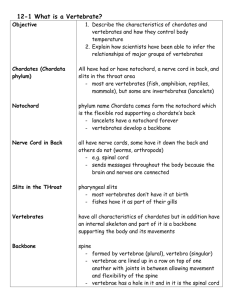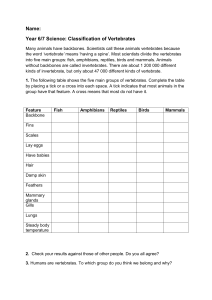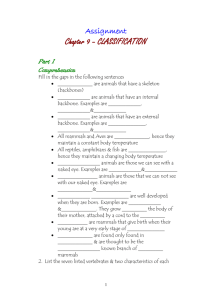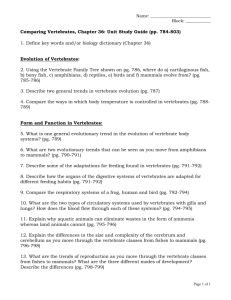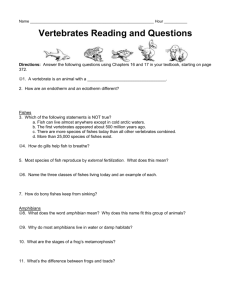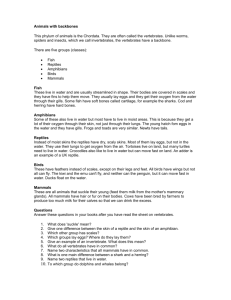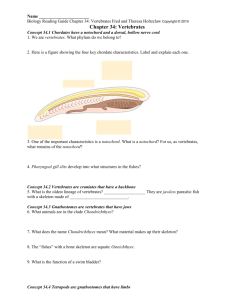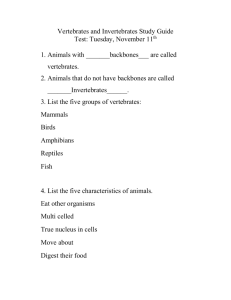Lecture 17 - vertebrates
advertisement
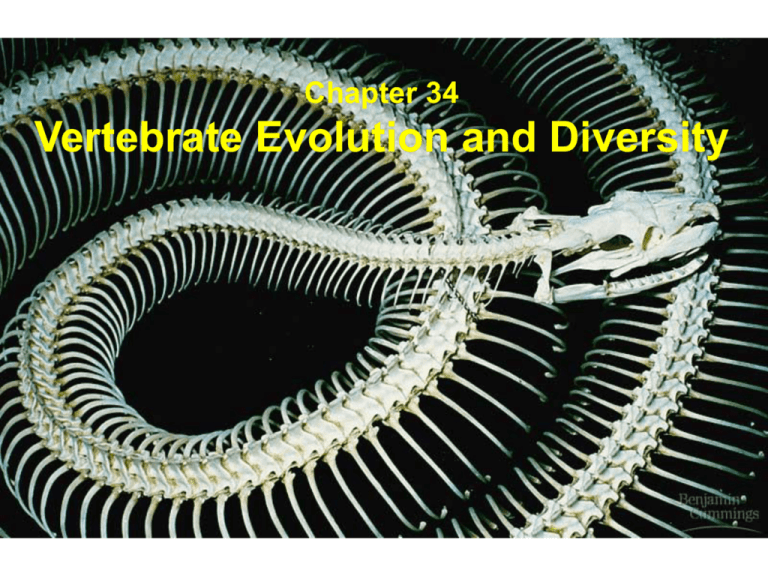
Chapter 34 Vertebrate Evolution and Diversity Four anatomical features that characterize the phylum Chordata 1. Embryos all have a common skeletal structure called a notochord. The notochord is a flexible rod located between the digestive tube and nerve chord. a. Provides skeletal support. b. In most vertebrates, it’s replaced by a jointed skeleton. c. Remains of the notochord exist as disks between the vertebrae. 2. Dorsal, hollow nerve cord a. Develops into the brain and spinal cord of the adult. 3. Pharyngeal slits Water enters through the mouth and passes out through the slits in the pharynx, without going through the digestive system. i. Slits function as suspension-feeding devices in many invertebrate chordates ii. Slits have been modified in more evolved vertebrates for: - Gas exchange - Hearing - Jaw support 4. Postanal tail Provides propulsion for swimming B. Invertebrate chordates provide clues to the origin of vertebrates 1. Subphylum Urochordata Adult is sessile and feeds via pharyngeal slits. Subphylum Urochordata: a tunicate 2. Subphylum Cephalochordata a. Adult form shows chordate features. b. Adults feed and swim. Subphylum Cephalochordata: the lancelet Branchiostoma II. Introduction to the vertebrates A. Neural crest, enhanced cephalization, vertebral column, and a closed circulatory system characterize the subphylum Vertebrata 1. Neural crest a. Embryonic feature that allows for many unique vertebrate characteristics, e.g. bones and cartilage are formed from the neural crest cells throughout the body. b. Forms along the dorsal side of the embryo. Figure 34.6 (p. 683) – The neural crest, embryonic source of many unique vertebrate characters. 2. Skeletal elements, such as the cranium (braincase), allow for the big evolutionary feature of vertebrates, cephalization. This gives us the term “Craniates” 3. Vertebral column is the main support for the body axis. It allows for large size, fast movement, and protection of the nerve cord. 4. The closed circulatory system pumps oxygenated blood to cells and allows rapid metabolism, rapid movement to search for food, escape predators. B. Overview of vertebrate diversity Figure 34.7 (p. 684) – Phylogeny of the major groups of extant vertebrates. **Note the three super groups: Gnathostomes, Tetrapods, Amniotes** III. Jawless vertebrates A. These are the most primitive vertebrates. B. Groups include hagfish (no skeleton, no notochord in adult); lamprey (early version of a vertebral column). Figure 34.8 (p. 685) – A hagfish. Figure 34.9 (p. 685) – A sea lamprey. Lamprey on trout IV. Fishes and amphibians A. Vertebrate jaws evolved from skeletal supports of pharyngeal slits 1. Animals that replaced jawless vertebrates, and are Gnathostomes. 2. Members of group have two pairs of fins. 3. Jaws and fins allowed fish to become active in pursuit of food and in biting off chunks of flesh. 4. Jaws evolved from modifications of skeletal elements of anterior pharyngeal gill slits. Hypothesis for the evolution of vertebrate jaws 5. Fishes were prevalent about 360 to 400 million years ago- the “Age of Fishes” 6. Two groups are alive today: a. Class Chondricthyes: Sharks and rays have cartilaginous skeletons Figure 34.11 (p. 688) – Cartilaginous fishes. Osteichthyes: Extant classes of bony fishes Lake trout Whitefish Sturgeon Great Lakes Walleye Some of the natives Rainbow trout/brown trout Alewife Smelt Great Lakes Some Exotics Ruffe Bluegill Yellow perch Great Lakes Some successors Largemouth bass D. Tetrapods evolved from specialized fishes that inhabited shallow water Figure 34.15 (p. 690) – The origin of tetrapods. 1. The first tetrapods to spend much time on land were amphibians. Figure 34.17 (p. 691) – Amphibian orders. Order Urodela – Salamanders, retain tails as adults Order Anura – Frogs, lack tails as adults Order Apoda – Caecilians, lack legs 2. There were earlier tetrapods. These were specialized fish that • occupied shallow ponds, • breathed air by gulping, and • developed lobed walking fins for moving from one pond to another. 3. Why go on dry land? There were no other competitors for plants and insects that serve as food. 4. Amphibians need to return to water to lay eggs and for development of larvae. Figure 34.18 (p. 692) – The “dual life” of a frog. V. Amniotes (includes reptiles, mammals, and birds) A. Evolution of the amniotic egg expanded the success of vertebrates on land Figure 34.19 (p. 693) – The amniotic egg. 1. Amniotic eggs allowed vertebrates to sever the link with water and live their whole lives on land. 2. Specialized membranes, called extra-embryonic membranes that function in gas exchange, waste storage, and transfer of nutrients. a. Membranes develop from tissues derived from the embryo. b. One membrane, the amnion, gives the name for the amniotic egg. B. Reptilian heritage is evident in all amniotes 1. Scales of keratin, waterproof skin - prevent dehydration. - Reptiles cannot breathe through skin, so all gas exchange occurs via lungs. 2. Shelled amniotic eggs require internal fertilization. Shell forms around fertilized egg in the reproductive tract. 3. Reptiles don’t use metabolism to regulate body temperature; they are ectotherms. Ectotherms absorb external heat (i.e. sunlight) Reptiles are able to survive on about 10% of calories required by mammals. 4. Oldest reptiles are from the late Carboniferous (about 300 million years ago) dinosaurs and pterosaurs. 5. Modern reptiles include 6,500 species that are in four groups: a. Testudines – Turtles - Some species returned to water; all lay eggs on land. b. Sphenodontia – Tuataras c. Squamata – Lizards, snakes - Lizards are the most numerous group. - Snakes are descendants of lizards and have vestigial pelvic and limb bones. d. Crocodilia – Crocodiles, alligators - This is the group most closely related to dinosaurs Figure 34.24 (p. 697) – Extant reptiles. C. Birds began as feathered reptiles, evolved to fly: 1. Honeycombed skeletons are light and strong good for flight. Figure 34.25 (p. 698) – Form fits function: the avian wing and feather. 2. Toothless for weight reduction. 3. Endothermic = use metabolic energy to generate heat. - Feathers provide insulation. - Efficient circulatory system supports high rate of metabolism necessary for flying. 4. Acute vision Large brains that allow complex behavior. 5. Wings - Flight enhanced the ability to hunt and scavenge, escape predators, and move with changing seasons. 6. Theropods were the closest dinosaur relative of birds. Example: Velociraptor Archeopteryx is an example of a Mesozoic bird that shows reptilian features. Figure 34.27 (p. 699) – Archaeopteryx, a Jurassic bird-reptile. 7. Modern birds include about 8,600 species. Some are flightless = ratites. Figure 34.29 (p. 701) – A small sample of birds. D. Mammals diversified extensively in the wake of the Cretaceous extinctions 1. Radiation of mammals occurred during two events: a. Extinction of dinosaurs b. Fragmentation of continents 2. There are about 4,500 species of extant mammals 3. Features of mammals: a. Defined by Linnaeus as having mammary glands, which produce milk rich in fats, sugars, proteins, minerals, and vitamins. b. Hair and subcutaneous fat help retain metabolic heat. c. Most embryos develop in a uterus. In placental mammals, the lining of the uterus and extraembryonic membranes form the placenta. d. Large brains and long period of parental care. Ability to learn. e. Differentiation of teeth for efficient eating. 4. The earliest mammals evolved from reptiles about 220 million years ago. Therapsids gave rise to mammals. Early example is the Morganucodon in previous figure. 5. Major groups of mammals: a. Monotremes – lay eggs and produce milk, but have no nipples. - Platypus, echidna b. Marsupials – born early in embryonic development; climb to mother’s pouch and attach to a nipple. - Opossum, kangaroo Figure 34.31 (p. 703) – Australian monotremes and marsupials. c. Eutherians – long pregnancy with embryonic attachment to mother in uterus via placenta. - Human, Wolf Figure 34.32 (p. 704) – Evolutionary convergence of marsupial and eutherian (placental) mammals. Table 34.1 (p. 705) – Major Orders of Mammals VI. Primates and the evolution of Homo sapiens A. Primate evolution provides context for understanding human origins 1. Hands and feet adapted for grasping. Possess opposable thumb. 2. Large brains allow complex social behavior. Figure 34.35 (p. 708) – A phylogenetic tree of primates. B. Hominid lineage diverged from other primates about 7 million years ago. Humans compared to other hominids: a. Brain size – large size allows development of language and social behavior. b. Jaw shape – shortened to give a flatter face. c. Bipedalism = walking on two legs. - Frees hands to do other things. - Eyes set higher; can see farther. d. Females smaller than males e. Extended parental care changes family structure and enhances learning and social behavior.
